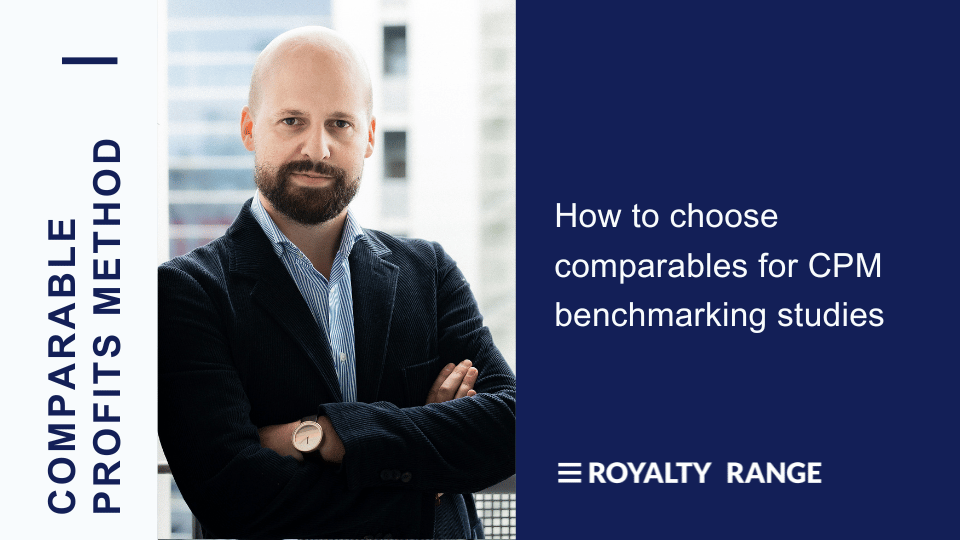How to choose comparables for Comparable Profits Method (CPM) benchmarking studies
RoyaltyRange

Transfer pricing is a highly complex and technical field. Even experienced corporate tax professionals and financial accountants can require help and frequent reminders of how to navigate the various stages involved and stay up to date with regulatory changes.
At the most fundamental level, though, transfer pricing is based on the arm’s length principle (ALP). The ALP is outlined in the Organisation for Economic Co-operation and Development (OECD) Transfer Pricing Guidelines (TPG) as follows:
“[Where] conditions are made or imposed between the two [associated] enterprises in their commercial or financial relations which differ from those which would be made between independent enterprises, then any profits which would, but for those conditions, have accrued to one of those enterprises, but, by reason of those conditions, have not so accrued, may be included in the profits of that enterprise and taxed accordingly.”
The aim of transfer pricing is to identify fair ‘arm’s length’ pricing for controlled transactions – that is, the exchange of goods, services or intangibles between related entities . It does this by comparing these controlled transactions with uncontrolled transactions between unrelated entities.
| Glossary |
| Controlled transaction:
A controlled transaction is an exchange of goods, services or intangibles made internally between related companies. There is no market to ensure a fair price is agreed by the buyer and seller, so fair ‘arm’s length’ pricing must be set in a different way.
|
| Uncontrolled transaction:
An uncontrolled transaction is an exchange of goods, services or intangibles made between unrelated companies. This kind of transaction is subject to market forces whereby independent parties agree on a fair price.
|
Below, we look at comparables in more depth – specifically, how to select comparables for benchmarking studies when using the Comparable Profits Method (CPM) method. But, first, we’ll go over the basics of the CPM.
You can find more general information on the five main transfer pricing methods here.
What is the Comparable Profits Method (CPM)?
The CPM is one of the five main transfer pricing methods accepted in the United States. It is equivalent to the Transactional Net Margin Method (TNMM) used outside the US.
Essentially, it compares profitability in controlled and uncontrolled transactions to determine whether the pricing in the controlled transaction is arm’s length.
What is the relevant regulation for the CPM?
The US transfer pricing regulations are found in the Internal Revenue Code Section 482. The regulations are consistent with the OECD TPG and ALP. The CPM is dealt with specifically in Treasury Regulation 26 CFR 1.482-5.
When do you use the CPM?
Grant Thornton notes that for transfer pricing in the US: “There is no hierarchy of methods, but the method used must be applied in a manner consistent with the functional and risk profile of the tested entity.”
The CPM is an acceptable method to use for transfers of tangible assets, intangible assets, or services – however, the onus is on the taxpayer to select the most appropriate method to give the most accurate arm’s length result.
What are the benefits of the CPM?
As the CPM requires access to financial data that is usually publicly available, it is relatively easy to use. It’s considered most suitable for transactions that are relatively simple, routine and low risk, such as intercompany exchanges of goods and services, where similar uncontrolled transactions can easily be found.
What are the limitations of the CPM?
As the CPM’s focus is on the profit margin charged by one of the parties involved in a transaction, it is sometimes considered one-sided and overly simplistic – possibly risking overlooking adjacent arrangements or intangible assets that may be involved in a transaction. For this reason, it is sometimes considered unsuitable for more complex business models and transactions, particularly where they involve intangible assets, such as the use of intellectual property (IP) in a creative technology company.
How do you use the CPM?
The CPM transfer pricing method requires you to identify similar companies engaged in comparable uncontrolled transactions. By analysing the financial data of these companies, an arm’s length range of profit can be established. A common measure of profitability is operating profit. If the profit from a controlled transaction falls within this range, it is deemed an arm’s length result.
How do you choose comparables for CPM benchmarking?
Selecting relevant comparables is a fundamental step in the CPM.
The objective of CPM benchmarking is to ensure the profit realised in a controlled transaction falls within an arm’s length range you can establish from analysing comparable uncontrolled transactions.
Once you’ve delineated and identified the terms of the controlled transaction, you can select the appropriate transfer pricing method and search for comparable uncontrolled transactions against which to benchmark.
Using a company financials database, you can enter parameters based on your analysis and delineation of the controlled transaction to generate a shortlist of potentially comparable uncontrolled transactions.
You can then refine this list by performing a comparability analysis covering the following factors:
- Characteristics of goods and services
- Functional analysis
- Contractual terms
- Economic circumstances
- Business strategies
Data and tools to simplify your CPM benchmarking study
“Any transfer pricing method relies on access to accurate data,” says Kris Rudzika, Managing Partner at RoyaltyRange. “A company financials database can help you access reliable data in a streamlined way, assisted by tools to make benchmarking studies quicker, easier and, ultimately, more accurate.”
Find out more about the comprehensive RoyaltyRange company financials database here and our transfer pricing benchmarking tool here.
Sources:
https://www.valentiam.com/newsandinsights/comparable-profits-method
The information provided below is for general informational purposes only and should not be construed as legal or tax advice. It is not a substitute for consulting with a qualified legal or tax professional.